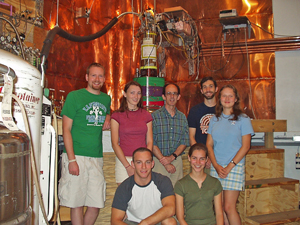
Possibly the best-known equation in all of science is Albert Einstein’s famous "E=mc2," which expresses that mass and energy are really different forms of the same thing. If the century-old equation were even slightly incorrect, the repercussions for modern physics would be enormous.
There’s no need to worry, though. Florida State University physicist Edmund G. Myers has collaborated with scientists from the Massachusetts Institute of Technology, the National Institute of Standards and Technology, the Institut Laue-Langevin (France) and the University of Oxford (England) to confirm that E=mc2 is true to within 4 tenths of 1 part per million, or 0.00004 percent—the most precise test of the equation ever conducted.
"Science has no such thing as orthodoxy—everything must be tested by experiment," Myers said of the scientists’ work. "Einstein’s theories have great mathematical beauty and have indeed stood the test of time. But the history of physics shows that progress often results from small discrepancies between accurate experiment and current theory. In fact, Einstein’s own work is a good case in point."
Einstein’s equation, published in October 1905, shows that it takes very little mass to generate a tremendous amount of energy. In E=mc2, the "E" stands for energy, the "m" stands for inertial mass, and "c2" stands for the speed of light multiplied by itself. E=mc2, therefore, means that the energy contained within something is equal to its mass times the speed of light squared. This is no small number; the speed of light is approximately 186,000 miles per second, so the energy equivalent of 1 gram of matter is 25 million kilowatt-hours!
Einstein’s equation gave science a radically different view of the physical nature of both mass and energy. In due course, it led to the realization that huge amounts of energy are liberated in nuclear reactions and explained why our sun is able to keep radiating energy for billions of years without quickly running out of fuel.
To test E=mc2, Myers and his colleagues worked in two groups. One group, working at a nuclear reactor in France, measured the energy ("E") liberated when neutrons were "captured" by nuclei of silicon and sulfur to form different isotopes. They did this using high-precision crystal diffraction to determine the energies of the gamma rays emitted.
Meanwhile, in Cambridge, Mass., Myers and his MIT colleagues measured the mass differences between the silicon and sulfur isotopes—to a world-record precision—using a special device called a Penning trap mass spectrometer. This provided the "m."
Using Einstein’s equation, the mass of a nucleus, after capturing an additional neutron, should be equal to the nucleus’s original mass plus the mass of the captured neutron, minus the energy of the gamma radiation emitted. That is indeed what Myers and his colleagues found—to within 0.00004 percent. The final results were 55 times more accurate than previous tests of E=mc2 and were published in Nature, one of the world’s most prestigious scientific journals. The publication was timed for the end of 2005—thus marking the 100th anniversary of Einstein’s annus mirabilis ("miraculous year") and the World Year of Physics.
The Penning trap used in this work was developed over a period of 18 years by the MIT group led by physicist David E. Pritchard. The world-record precision was obtained using a newly developed technique in which the two ions being compared are simultaneously trapped in the Penning trap. (Incidentally, one of the MIT researchers most responsible for this development, James K. Thompson, received his bachelor’s and master’s degrees at FSU before moving to MIT.) The E=mc2 test also represented the last work with this system at MIT; thanks to a prior agreement with Pritchard, the spectrometer since has been relocated to FSU under the direction of Myers.
"The scientific method is so valuable to society because even the most well-accepted theories will be changed if new tests show that they are wrong, even in the slightest," said Professor David Van Winkle, chairman of FSU’s physics department. "We are privileged to have scientists such as Dr. Edmund Myers performing such careful and fundamental experiments right here at FSU."




